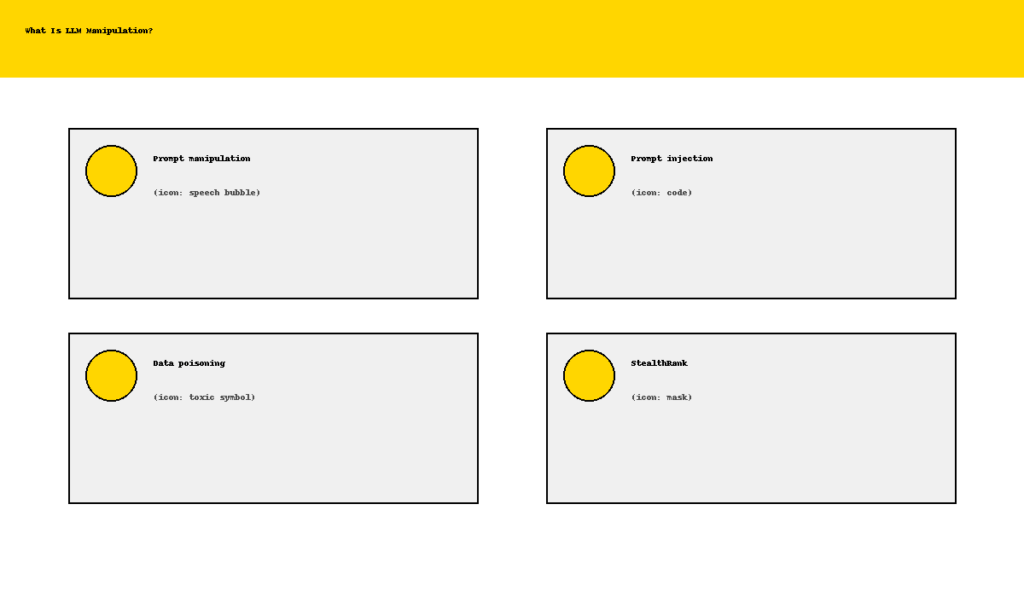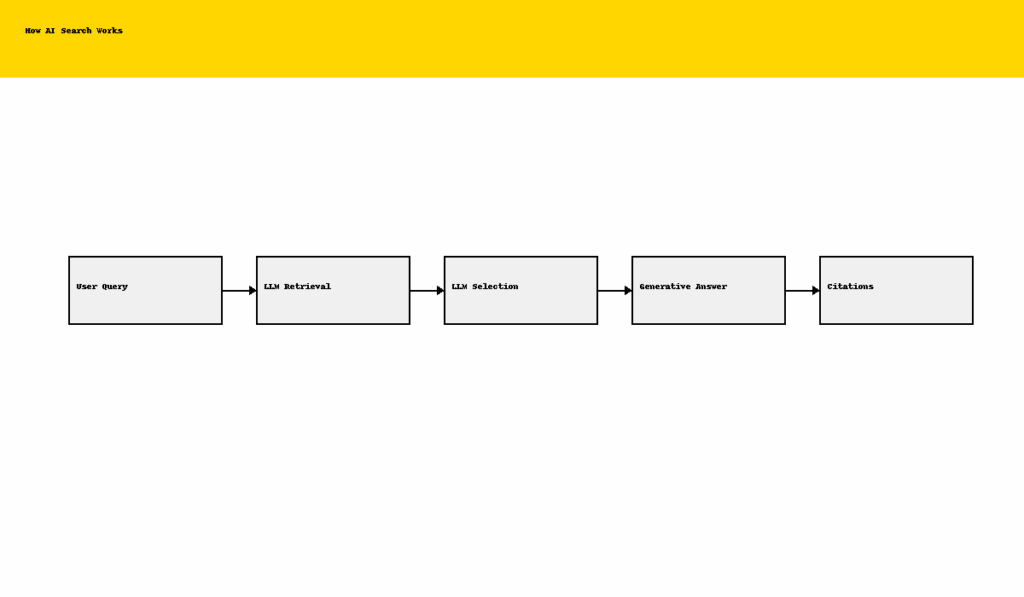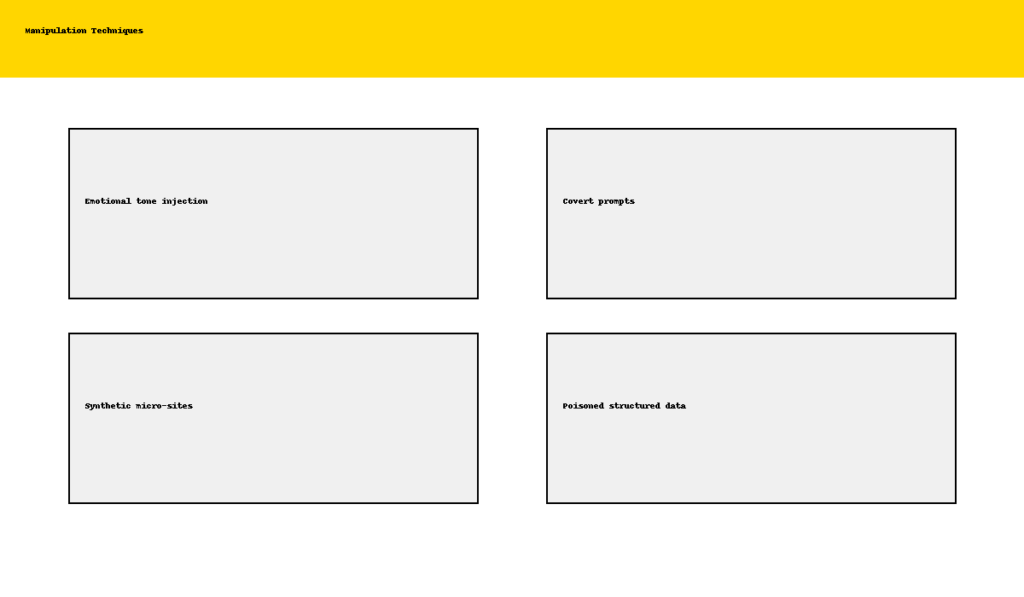An IncRev SEO Research Article – 2025 Edition
1. Introduction: AI Search Is Reshaping the Information Economy
Search has changed more in the last two years than in the previous two decades. Instead of ten blue links, users increasingly see AI-generated answers produced by large language models (LLMs) such as ChatGPT, Claude, Gemini, and Perplexity. These systems do not only index the web; they interpret it, compress it, and synthesize it into conversational responses.
For businesses, the challenge is no longer limited to ranking number one on a search engine results page. The new question is more fundamental: will AI search engines choose to cite your content at all? If your brand is not selected as a source, you effectively become invisible in AI-driven search.
This has created a new branch of SEO often called AI SEO or LLM SEO. At IncRev, we have explored this evolution in depth in several research pieces:
– Semantic vectorization and how it changes SEO: https://increv.co/academy/seo-research/semantic-vectorization-seo/
– What generative engine optimization (GEO) is and how to do it: https://increv.co/academy/ai-search-visibility/what-is-generative-engine-optimization-and-how-to-do-it/
– GEO vs traditional SEO: https://increv.co/academy/ai-search-visibility/geo-vs-seo-key-differences-and-similarities/
– SEO for ChatGPT-4 and other LLMs: https://increv.co/academy/ai-search-visibility/seo-for-chatgpt-4-key-steps-for-success/
As AI-SEO emerges, so does an uncomfortable truth: LLMs can be manipulated. Research shows that generative models are susceptible to stealthy linguistic patterns, emotional cues, covert instructions, poisoned datasets, and specially crafted content designed to influence their output. This creates a dual responsibility: to understand how manipulation works, and to build AI-SEO strategies that avoid it and actively counter it.
2. What Is LLM Manipulation?
LLM manipulation refers to the practice of influencing or controlling the outputs of large language models in ways that were not intended by their designers. In an AI-SEO context, this often means trying to push a model to repeatedly recommend, cite, or praise specific brands, products, or narratives through subtle or deceptive means.

Figure 1. Overview of four core types of LLM manipulation: prompt manipulation, prompt injection, data poisoning, and StealthRank-style stealth optimization.
2.1 Prompt manipulation
Prompt manipulation uses specific linguistic patterns, framing, and emotional language to steer an LLM towards a desired style, stance, or conclusion. At small scale this may look like normal copy optimization; at large scale with deceptive goals it becomes a form of manipulation.
2.2 Prompt injection
Prompt injection embeds hidden instructions inside publicly visible text, such as HTML attributes, alt text, or long FAQ blocks, that an LLM may interpret as part of its own instructions. When crawled or retrieved as context, these injections can alter how a model responds or which sources it prefers to cite.
2.3 Data poisoning and model grooming
Data poisoning, sometimes called model grooming, happens when actors publish misleading or adversarial content specifically to pollute the data that LLMs learn from or retrieve. Examples include fake expert blogs, coordinated networks of synthetic sites, or manipulated reference articles aimed at influencing how models answer high-value questions in finance, health, or politics.
2.4 Stealth optimization (StealthRank-style attacks)
Recent research on StealthRank-style attacks shows that it is possible to inject subtle, hard-to-detect text patterns into documents that make LLM-based ranking or recommendation systems more likely to favor those documents. This is the closest modern equivalent to black-hat SEO aimed directly at AI models rather than classic search engines.
3. What the Latest Research Reveals About Manipulating LLMs
Academic work over the last few years has highlighted how vulnerable LLMs can be to both content-level and system-level manipulation. Studies on stealth ranking attacks, emotional prompt engineering, and misinformation pollution all converge on a key insight: if an actor controls input data and linguistic patterns at scale, they can often shift how LLMs prioritize or describe information.
3.1 Stealth ranking and covert optimization
Stealth ranking research demonstrates that by optimizing small segments of text using gradient-based or search-based methods, an attacker can increase the likelihood that a product or page is chosen by an LLM-driven ranking or recommendation system. These perturbations are designed to look natural to humans while being disproportionately salient to the model.
3.2 Emotional prompt manipulation
Other work shows that emotional framing, such as amplifying urgency, fear, outrage, or enthusiasm, can change how LLMs generate content. In a disinformation context, this can make false narratives more persuasive. In a commercial context, the same techniques could in theory be used to bias product descriptions, comparative reviews, or the tone of AI-generated recommendations.
3.3 Misinformation pollution and data poisoning
Research on misinformation pollution underscores that LLMs are more likely to repeat false claims when those claims are abundant and structurally similar across multiple sources. Coordinated poisoning campaigns can therefore influence not only human readers but also AI systems that depend on those sources for training or retrieval.
4. How LLM Manipulation Impacts AI Search Visibility (AI-SEO)
To understand why LLM manipulation matters so much for SEO, we need to look at how AI search engines actually work. Unlike traditional search engines that display a ranked list of links, AI search systems first generate an answer and then attach citations to support it.

Figure 2. Simplified flow of an LLM-based AI search experience, from the initial user query through retrieval and model selection to the final generative answer and its citations.
4.1 Selection instead of ranking
In AI search, the visible outcome is not a list of ten options but a single synthesized answer and a small set of sources cited as evidence. If your content is not selected for that answer, you get no visibility for that query. This creates a winner-takes-all dynamic and raises the stakes for being included as a cited source.
4.2 What LLMs prefer to cite
LLMs tend to favor content that is clear, semantically rich, entity-focused, and demonstrably trustworthy. Practically, that means explicit definitions, step-by-step explanations, structured data, clearly labeled entities, and alignment with other credible sources. This connects directly with semantic vectorization and GEO: models do not only look at keywords, but at meaning and relationships.
For more on this, see our articles on semantic vectorization and generative engine optimization:
– https://increv.co/academy/seo-research/semantic-vectorization-seo/
– https://increv.co/academy/ai-search-visibility/what-is-generative-engine-optimization-and-how-to-do-it/
4.3 Emerging manipulative AI-SEO tactics
As AI search becomes more influential, new manipulative tactics emerge that attempt to game the LLM selection process itself rather than the traditional SERP ranking.

Figure 3. Key manipulation techniques targeting AI search and LLMs, including emotional tone injection, covert prompts, synthetic micro-sites, and poisoned structured data.
Typical patterns include AI-bait microsites filled with low-value FAQ content, covert prompt stuffing inside HTML attributes and metadata, semantic noise flooding through large volumes of near-duplicate articles, and synthetic link or citation networks that try to imitate genuine authority.
5. Why LLM Manipulation Is Dangerous (For Users and Brands)
LLM manipulation is not just a technical trick. It has real consequences for end users, for brands, and for the integrity of the information ecosystem. Understanding these risks is essential before we even begin to talk about AI-SEO strategy.

Figure 4. Major risks of LLM manipulation: loss of user trust, incorrect or biased answers, degradation of model quality over time, and significant legal or ethical exposure for brands.
5.1 User trust and answer quality
When AI systems surface manipulated or low-quality content, users receive answers that are incomplete, biased, or simply wrong. Over time, this erodes trust both in AI technologies and in the brands that appear prominently in AI-generated answers.
5.2 Brand integrity and reputation
If a brand is found to be engaging in deceptive tactics, like prompt injection, synthetic blogs, or fake citation networks, its credibility can collapse. Journalists, regulators, and customers are increasingly alert to the ways AI can be abused in marketing and communications.
5.3 Ecosystem degradation and feedback loops
Manipulated content does not only affect one model or one answer. It pollutes the underlying data pipelines that future models and retrieval systems rely on. This creates negative feedback loops where misinformation and low-quality signals are amplified instead of corrected.
6. Ethical AI SEO: Principles for Responsible Generative Search Optimization
As AI search matures, ethical AI-SEO becomes not just a moral preference but a strategic necessity. At IncRev, we believe that AI-SEO should help users access accurate, valuable information, not manipulate their access to information. This belief underpins our framework for responsible AI search optimization.

Figure 5. The IncRev ethical AI-SEO framework, built on clarity, accuracy, credibility, trustworthiness, and a long-term approach to search visibility.
6.1 Build for understanding, not exploitation
We design and optimize content so that LLMs can genuinely understand and use it: clear structure, precise explanations, explicit entities, and helpful context. We do not rely on hidden instructions or adversarial triggers.
6.2 Prioritize high-trust, verifiable sources
Our AI-SEO strategies emphasize placing clients inside high-trust ecosystems. That means being cited by reputable domains, appearing in credible industry publications, and aligning content with stable, verifiable knowledge sources.
6.3 Avoid manipulative patterns
We explicitly avoid AI-bait microsites, semantic flooding, covert prompt stuffing, and synthetic link schemes. These tactics may produce short-term visibility spikes, but they are fragile, non-compliant, and harmful to long-term performance.
6.4 Respect genuine user intent
Our goal is to answer the user’s real question as well as possible. We do not attempt to hijack unrelated queries, mislead users about what a page delivers, or obscure important trade-offs in order to drive conversions.
6.5 Focus on value, accuracy, and utility
The strongest long-term AI-SEO strategy is still to produce content that is correct, useful, and practically actionable. Models are becoming better at detecting shallow or manipulative patterns, but they continually reward content that genuinely helps users.
7. IncRev’s Approach: Long-Term, Trust-Focused AI SEO
IncRev takes a clear stance against LLM manipulation. We reject it not only because it is ethically questionable, but because it is commercially fragile. As AI systems harden and regulators catch up, manipulative tactics are likely to become liabilities, not assets.
Instead, we focus on credibility, clarity, and long-term trust signals. We help clients become ‘AI-citable’: their services, products, and thought leadership are presented in ways that make it natural for LLMs to cite them as reliable sources. This includes strong semantic structure, robust entity coverage, clean technical implementation, and distribution strategies that earn citations from trusted publications rather than from disposable microblogs.
For clients who want to go deeper, we connect AI-SEO work with broader generative engine optimization practices, as described in more detail in our GEO and ChatGPT-4 SEO guides:
– https://increv.co/academy/ai-search-visibility/what-is-generative-engine-optimization-and-how-to-do-it/
– https://increv.co/academy/ai-search-visibility/geo-vs-seo-key-differences-and-similarities/
– https://increv.co/academy/ai-search-visibility/seo-for-chatgpt-4-key-steps-for-success/
8. Future Outlook: How AI Search Will Evolve (2025-2030)
Looking ahead, we expect AI search to become more transparent, more citation-driven, and more sensitive to trust and provenance. The following trends are particularly important for anyone investing in AI-SEO today.

Figure 6. Expected evolution of AI-SEO from 2025 to 2030, with growing detection automation, stronger semantic authority, dedicated trust layers, and a shift toward high-quality citations dominating AI-generated answers.
8.1 Trust layers inspired by TrustRank-style algorithms
We expect LLM-based systems to introduce dedicated trust layers that operate in a similar spirit to Google’s TrustRank concepts, where a small set of highly trusted ‘seed sites’ are used as anchors for evaluating the rest of the web. For more background on this style of thinking, see our overview of TrustRank and trust-based ranking signals: https://increv.co/academy/google-trustrank/
8.2 Seed sites and cleaning up AI-visible spam
If AI search engines adopt seed-site style algorithms in their trust layers, they can use those seeds to filter out spammy microblogs and low-quality domains that attempt to flood the topical vector space with incorrect brand mentions. In practice, this means that content which is far away from credible seed sites in the link and entity graph may be heavily downweighted or ignored by LLMs. We have explored the importance of proximity to seed sites in our research on fast indexing and authority: https://increv.co/academy/seo-research/how-close-are-you-to-googles-seed-sites-the-hidden-factor-behind-fast-indexing/
8.3 Entity authority and semantic reputation
Authority will continue to shift from being purely domain-based to being entity-based. Experts, organizations, and products with strong, consistent signals across multiple platforms will be favored in AI-generated answers, particularly when those signals are reinforced by trusted seed sites.
8.4 Better detection of manipulation patterns
Patterns of prompt injection, semantic flooding, and synthetic site networks will become easier for AI systems to detect as trust layers and citation filters mature. This will gradually erode the effectiveness of black-hat AI-SEO strategies.
8.5 Ethical AI-SEO outperforms black-hat tactics over time
In the long run, strategies that align with user value, factual accuracy, and system integrity are more likely to be rewarded. Ethical AI-SEO, built on high-quality citations and proximity to trusted seed sites, is therefore not only the right thing to do; it is also the most robust commercial bet for the next decade.
Deep dive into mathematical modeling for SEO, AI search, link building, TrustRank and seed sites research on David Vesterlund’s profile on Academia.edu: https://independent.academia.edu/DavidVesterlund
References
Tang, Z., Liu, Y., & Zhao, W. (2025). StealthRank: LLM ranking manipulation via stealthy prompt optimization. arXiv preprint arXiv:2504.05804.
Vinay, V., Vadori, N., & Wahle, J. P. (2024). Emotional manipulation through prompt engineering amplifies disinformation generation in AI large language models. arXiv preprint arXiv:2403.03550.
Pan, L., Zhang, D., & Chen, W. (2023). On the risk of misinformation pollution with large language models. arXiv preprint arXiv:2305.13661.
Chen, Y., Yang, L., Zhang, T., & Wang, X. (2025). Role-augmented intent-driven generative search engine optimization. arXiv preprint arXiv:2508.11158.


